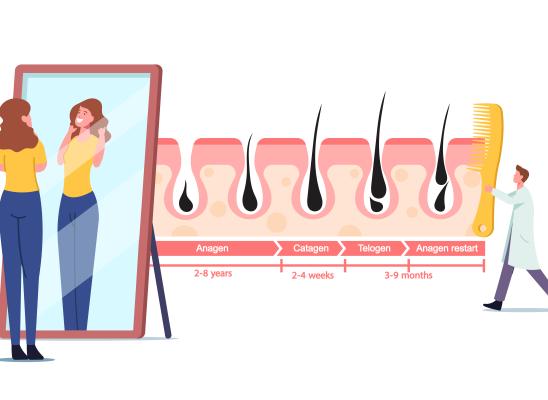Hair Pulling Trances: What We Know About Them

Online test
Find out the severity of your symptoms with this free online test
In a recent TrichStop.com webinar, Dr. Vladimir Miletic tackled the topic of hair-pulling “trances”. While this behavior is something we know happens, there is surprisingly little literature on this phenomenon. Much of what we know about trance pulling comes from anecdotal evidence. In other words, people report doing it and talk about it. So, just what do we know about trances? Turns out, quite a bit.
Defining A Hair Pulling Trance
A hair-pulling trance is a prolonged episode of hair-pulling that is all-engaging. The person becomes intently focused and completely absorbed in the experience of pulling. They may be completely unaware of what’s happening around them and they might not even be aware that they’re pulling. As a result, the use of competing responses is rather ineffective because they’re not going to attend to it. The focus of the trance is pulling.
The Purpose of A Trance
You might wonder just why someone might become so immersed in the act of pulling and what purpose it serves. Trance pulling has an extreme quality of emotional avoidance. When engaged in pulling, time seems to stop and all focus is on the pulling. The person experiences relief from their distress without having to deal with the stressors directly.
How Trance Behavior Develops
You probably don’t just wake up one day and decide that today is the day you will pull in a trance. Behaviors develop over time. So, just how does trance behavior develop? To answer that, Dr. Miletic turns to the work of George Kelly’s personal construct theory.
Dr. Kelly believed that every person is a scientist and is constantly gathering information and evaluating their world, acting in ways based on what they experience. In short, they learn to do what works for them. Behavior wasn’t viewed as “good” or “bad”. It simply served a purpose stemming from their experiences and was either constrictive (avoidant) or dilating (engaging). The trance state is an extreme avoidance response. The trance essentially reduces the person’s world to hair pulling and avoids the need to deal with all of the distress.
Sometimes this process of experiencing, evaluating, and acting is in their awareness but can also occur completely outside of their awareness. Trance pulling (an avoidance behavior) develops in response to intense difficult emotions that the person wishes to avoid. Hair pulling in a trance allows the person to alleviate the distress while avoiding having to deal with the distressing emotions and issues associated with it.
If you’ve developed a trance hair-pulling behavior, there are things you can do to change the behavior. Just as behavior is learned through one’s interpretation and response to experiences, it can be changed via the same process.
Stopping A Trance – Be Prepared
The first step in stopping your trace is understanding the way your trance unfolds and the experiences that shape your trance behavior.
Reflect on your experience with trances:
- Do they come on suddenly or gradually?
- What do you think triggers your trances? Are your triggers internal or external?
- Where are you when your trances happen?
- Who is near you when they happen?
- What emotions are you struggling with or not understanding?
Next, make a plan to deal with trances. What can you do when you find yourself on the verge of entering into the trance-state? You want to choose actions that are easy to use and easy to remember because you want to act quickly. Dr. Miletic offers these strategies:
- Try breathing exercises such as box breathing or 3x3, even a breathing app is ok. The goal here is to reduce tension by controlling your breath, not simply be aware of your breathing as with meditation.
- When you feel you’re about to go into a trance, let it RAIN. RAIN stands for Recognize, Accept, Investigate, Nurture. The rain is a mindfulness technique but you are not going to engage in meditation. Rather you are going to use the technique as a way to circumvent the urge to pull.
Recognize what is happening.
Allow the experience to be there, as is, with no judgment.
Investigate with kindness.
Nurture with self-compassion.
RAIN allows you to recognize what’s happening and slightly detach yourself from it. You don’t detach enough to dissociate because that invites pulling. Rather, you detach enough to still feel the urge but not let it overwhelm you. Allow your curiosity to find the truth of what you’re feeling. Explore what you’re feeling, not just the urge but the emotions you’re feeling and trying to avoid. Where are you feeling it? As you are acknowledging your feelings, notice whether your body is relaxing or holding tension. Simply be aware.
- Engage in some emotional self-talk. Say out what you’re feeling out loud and speak slowly. Allow yourself to hear and react to what you’re saying. Let yourself connect with what you’re feeling. Doing so connects you to what you’re trying to avoid and dissolves the trance.
- Practice grounding. Grounding allows you to shift your focus onto something else and anchor yourself to that. A great grounding technique is popularly referred to as 5-4-3-2-1. Simply, you focus on five things you can see, four things you can hear, three things you can feel, two things you can smell, and one thing you can taste. As you do this, you’re shifting your focus away from the internal experience of the urge onto something external, diminishing the intensity of the urge to pull. A quick body scan can also ground you in the moment.
- Use external distractions. Take a cold shower. Enlist the support of an accountability partner.
- Redirect your energy and focus elsewhere. This is not a competing response strategy. Instead, this means physically shifting to something else. Take a walk or a run. Try some boxing. Hit a pillow. Look for some ways to expend energy. The trance state is driven by heightened anxiety which in itself is highly-charged. The goal here is to find a way to expend that intense energy in safe ways.
So there are ways to stop a trance. Are there ways to prevent trance behavior? The answer is yes.
Trance Prevention
Prevention is not just stopping the trance from happening. Prevention goes a step further to alleviating the preventable causes or triggers. Dr. Miletic describes this process as “focus on all of those things that will cause the trance and then work on removing them from your life.” This process may include things like changing or redefining your roles, setting new boundaries with others, saying no when you need to, or striking a healthy work-life balance. It’s a process of discovery to determine those stressors that stack up and create distress that is the precursor to your trance. Check in with yourself regularly to see how you’re managing and what may be creating distress.
Ultimately, to eliminate avoidance behavior like trace hair pulling, you have to allow yourself to be open to difficult experiences. Kelly believed that people’s experiences are not linear or superficial. They are complex and multi-layered. It takes time to understand how and why behaviors develop and persist. When you open yourself up to deal with the hard emotions and experiences, you open yourself to the possibility of growth and change. Instead of fearing and avoiding difficult experiences, allow yourself to see what they can teach you. What wisdom can you take from them? This can be a difficult journey to take alone. Working with a therapist can help guide you through this journey of discovery.
Watch the Original Webinar by Dr Vladimir Miletic:
Online test
Find out the severity of your symptoms with this free online test
Start your journey with TrichStop
Take control of your life and find freedom from hair pulling through professional therapy and evidence-based behavioral techniques.
Start Now



